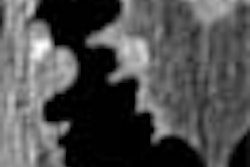Why do coronary calcium screening at all? It’s an appropriate question to ask Dr. Jerome Breen, a consultant in cardiovascular radiology at the Mayo Clinic in Rochester, MN. Breen led the quest for an answer at the 2003 Symposium on Multidetector-Row CT in San Francisco. And given all the hype and hucksterism surrounding the procedure, a dash of skepticism is what this doctor ordered.
"Isn't this just another area that will require our group to spend significant amounts of time and effort to develop the expertise needed to perform and promote these exams -- just so some cardiologists will try and take them away from us anyway?" Breen asked.
Well, yes it is, he answered himself, "but other than mammography, what isn't somebody trying to take away?" Truth is, radiologists who don't offer calcium screening will find there are many others who are willing to do so, he said.
"Patients are asking for the exam," Breen continued. "It helps establish you as a cardiac imager...Oprah (Winfrey) had it, so there's a real good reason. And it probably is a useful test, but in the right patient population."
Beyond even the Oprah model, there are hundreds of studies covering every aspect of coronary calcium, Breen said as he prepared to tear through several dozen of them. Among the earliest is a study by Dr. David Blankenhorn and colleagues in the May 1959 American Journal of Roentgenology. The researchers x-rayed a series of cadavers -- patients who had died of heart disease -- and found visible calcium in the coronary arteries.
"There is some promise that a roentgenographic method might be useful at a time of life when it is particularly important to recognize coronary atherosclerosis before it leads to ischemic heart disease," the authors wrote (AJR, May 1959, Vol. 81, pp. 772-777).
A 1970 study found that the greater the calcification, the more likely the presence of significant narrowing of the coronary vessels. Subjects without visible calcium were the least likely to have significant stenosis (American Journal of Cardiology, September 26, 1970, Vol. 26:3 pp. 241-247).
Ten years later came a direct link between coronary calcium and mortality. Among 600 patients screened with CT, those with calcification demonstrated poorer survival at all follow-up intervals (Radiology, December 1980 Vol. 137:3, pp. 609-616).
"The Internet's just great for coronary calcium," Breen said. "If you go to the American Heart Association (site) I think you get a lot of honest information. They came out with this white paper in 2000. It's a bunch of believers, some zealots, and some who actually abhor the idea of coronary calcium screening."
The AHA's consensus statement declares that "a negative EBCT test makes the presence of atherosclerotic plaque, including unstable plaque, highly unlikely," and that "a negative test is highly unlikely in the presence of significant luminal obstructive disease."
Conversely, "the greater the amount of calcium, the greater the likelihood of occlusive CAD, but there is not a 1:1 relationship, and the findings may not be site-specific," according to the statement. It concludes, however, by saying that although preliminary data are intriguing, they are insufficient to recommend calcium screening to the general public, adding that more studies are "enthusiastically recommended."
A large 1996 study concluded that EBCT predicts future atherosclerotic disease events in asymptomatic subjects. For calcium-score thresholds of 100, 160, and 680, EBCT yielded sensitivities of 89%, 89%, and 50%, and specificities of 77%, 82%, and 95%, respectively (Circulation, June 1, 1996, Vol. 93:11, pp. 1951-1953).
However, a 1999 paper in Circulation came to the rarer conclusion that scanning was not a good predictor of future events in some subjects. Over 41 months, the study followed 1,196 subjects at high risk of coronary events based on the Framingham model and calcium scanning. In all, 68% of subjects (n=818) had detectable coronary calcium, but there were just 17 coronary deaths (1.4%) and 29 nonfatal infarctions (2.4%).
"Neither risk-factor assessment nor EBCT calcium is an accurate event predictor in high-risk asymptomatic adults," the authors stated. "EBCT calcium score does not add significant incremental information to risk factors, and its use in clinical screening is not justified at this time" (Circulation, May 1999, Vol. 99:20, pp. 2633-2638).
A 1998 meta-analysis of six coronary calcium studies (2,700 patients) found that EBCT had an overall sensitivity of 91% and specificity of 55% for the detection of any coronary disease (Journal of Insurance Medicine, 1998, Vol. 30:3, pp. 175-179).
A 2001 study correlated coronary calcification with angiographically documented stenosis, Breen said. According to the results, only five of 1,764 patients with significant stenosis at angiography had negative CT scans (NPV > 99.7%) Journal of the American College of Cardiology, February 2001, Vol. 37:2, pp. 451-457.
But there are problems in NPV paradise, beginning with the fact that many symptomatic patients are indeed positive for coronary calcium. So then what? With the positive predictive value (PPV) of calcium presence being much lower than the NPV, a positive score per se doesn't provide a lot of guidance.
A good example of the calcium quandary can be seen in a letter a patient wrote to the Harvard Heart Letter a few years back, Breen said.
'"I do not have any symptoms of heart disease, but a note was sent to my doctor saying that I had a lot of calcium in my coronary arteries, and my doctor isn't sure what to do,"' Breen read from the letter. '"What does this test result mean?"'
"It means you're going to die!" he said, "someday -- and not necessarily from heart disease." Or else it means "you're going to live!" he continued. "The reason you're going to live -- for now -- is that you found this heart disease and you actually did something about it."
Breathlessly upbeat calcium-screening ads promising a "new age" in preventive medicine, or even the elimination of heart surgery altogether, can confuse patients mightily, Breen said. Moreover, a sedentary, obese individual with high cholesterol shouldn't have to buy a calcium-screening exam to know he is at high risk for heart disease.
But a scan can help determine whether someone's unhealthy lifestyle has begun to have negative effects on his cardiovascular health. And ideally, it can persuade the patient to begin drug therapy or make healthy lifestyle changes.
But in that case who needs calcium scoring?, Breen added. "You could have waved a cigarette lighter over the patient...and done the same thing."
Quoting a physician in one screening ad, Breen said, '"Nothing is as powerful a motivator as sitting down at the computer with a patient and showing them a giant hulking mass of plaque in their heart."'
The problem with negatives
Lest a high NPV engender complacency, it is important to remember that even a negative calcium scan cannot rule out 100% of coronary disease.
"There are still too many people with low calcium who go on to death," Breen said. "Here's where I think the multislice is going to help us a little bit."
One group of patients that causes endless headaches for ER physicians -- and is a principal cause of lawsuits -- are those who are admitted with chest pain, but have negative enzymes, unremarkable ECG results, and negative calcium. "(Doctors) think it's gastritis or something and send them home, and they go ahead and have an infarct," Breen said.
Breen and colleagues at Mayo scanned just such a group of patients -- who had chest pain, nondiagnostic ECG, and negative initial enzymes -- and then followed them for as long as two years, presenting the results in 1990. The NPV was 100%, i.e., anyone with a negative scan remained free of any kind of coronary event, Breen said.
"We continued this study for 250 people and sure enough, one guy had to ruin it," he said. The spoilsport was negative for calcium, enzymes, and ECG, but turned up with a 50% circumflex stenosis.
A similar 2001 study scanned 192 patients admitted to the emergency department for chest pain syndromes, following them for an average of 50 months. Among the 58 patients who had subsequent coronary events, the presence of calcium and increasing score percentiles were strongly related to the occurrence of hard cardiac events including MI and death (p < 0.001).
"This study supports the use of (electron-beam tomography) in a symptomatic cohort with prompt discharge of those patients with negative scans," the authors concluded (Journal of the American College of Cardiology, July 2001, Vol. 38:1, pp. 105-110).
Cheap ways to lower your score
If coronary calcification has got you down, you can always have a few drinks and make things better, Breen said. A 1999 study concluded that "Alcohol consumption is a significant inverse predictor of coronary events, comparable in magnitude to standard risk factors, and to radiographically measured coronary calcium" (American Journal of Cardiology, October 1, 1999, Vol. 84:7, pp. 802-806).
"But don't become an angry drunk," he warned. In CARDIA study results published a year later, high hostility may predispose young adults to coronary artery calcification (Journal of the American Medical Association, May 17, 2000, Vol. 283:19, pp. 2546-2551.
Prognostic value in high-risk males
A European study published in May 2003 looked at the prognostic value of extensive coronary calcium in 150 symptomatic males, 50 with calcium scores greater than 1,000, and 100 who scored between 100-400 and 400-1,000, with a five-year follow-up. The subjects underwent angiography in addition to EBCT, and were assessed for other risk factors. Over five years there were 17 deaths, two infarcts, and three strokes in 21 patients.
Cardiac events occurred earlier and more frequently in patients with scores higher than 1,000, the authors wrote. Left main disease was the only independent predictor of hard coronary events such as MI and death; only calcium scores in the 90th percentile and greater independently predicted all events, the authors wrote.
"Symptomatic males with extensive (calcifications) carry an even higher risk for future events than other symptomatic males with advanced CAD," the authors concluded. "In these patients, EBT-based calcified plaque burden and angiographic indices of disease severity may have a complementary role in predicting future cardiovascular events."
Over the next decade, large population-based studies in progress, such as the Multi-Ethnic Study of Atherosclerosis (MESA), are expected to provide additional evidence on the value of coronary calcium screening, Breen said.
Screening for coronary disease is gaining momentum as a utilized clinical tool, Breen concluded. "Longitudinal studies will provide the proof whether it is a useful clinical tool, and the data to date suggest it will thrive," he said. "Hey, I know my calcium score, it's zero. I'm going to live forever. Do you (know yours)?"
By Eric BarnesAuntMinnie.com staff writer
August 6, 2003
Related Reading
Study finds blacks have less coronary calcium than whites, February 17, 2003
Thin-collimation MDCT identifies more coronary calcium, December 18, 2002
Population-based study links coronary calcium and mortality, December 1, 2002
Technology keeps CT vital for coronary assessment, November 13, 2002
CT calcium scoring works, but what does it mean?, January 8, 2002
Copyright © 2003 AuntMinnie.com




















